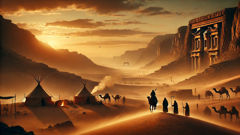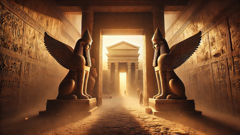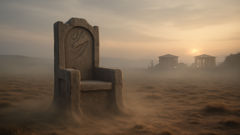Introduction
Wind scoured the stony ridges of the Eastern Desert as if it were an unseen drummer keeping time for travelers who dared to cross that endless salt and sand. The sun, a brass coin in a sky of relentless blue, burned the horizons into a distant, shimmering promise of survival and peril. Here, where intermittent wadis cut like veins into the earth and where the ancient routes to Nubia and the Red Sea threaded between ridges of granite, roamed a people whose name would come to be whispered in the courts of pharaohs and carved into the margins of temple walls: the Medjay. They were born of salt, rock, and wind—nomads who read the desert the way others read maps; whose eyes could find water where others saw only dust; whose feet left patterns that told of hunting, of kin, and of rites older than cities. This is not a dry recitation of fact but a mythic tracing of how desert-born scouts rose into guardians of the sacred and the sovereign. You will meet their leaders, their rites of passage, and the sacred bargains they struck with gods and kings. You will walk beside them on midnight patrols beneath a wash of stars and sit across from them by firelight as they weigh the price of loyalty. This tale folds together the archaeological shadows and the human voice—an imaginative retelling rooted in the skills and spirit attributed to the Medjay, meant to illuminate how a wandering people became the bulwark between the living and the divine in ancient Egypt.
From Nomads to Guardians: The Making of Medjay
They called themselves by the names of animals and winds: sons of the ibex, daughters of the sand, children of the salt flats. To outsiders they were simply Medjay—an exonym that would collect legend as it traveled on the lips of traders and scribes. In the earliest gatherings, their identity was practical rather than ceremonial. The Eastern Desert demanded skills that cities did not teach: the reading of stone, the following of a single track across days of sameness, an instinct for weather shifts and a knowledge of how to coax water from a reluctant earth. Boys were taught to carry patience like a blade; girls learned tracking as tenderly as midwives learn the curve of a newborn. The first rite that marked a child’s passage was the Night of Listening. Under a bowl of stars they were woken without word and led to a rocky outcrop. The elder placed a palm flat against the child’s heart and told them the names of constellations that would guide caravans. ‘‘When you can sleep on the sand and awake to the tell of wind and stone, you will know the desert as your kin,’’ the elder intoned. This intimacy with the land created the practical excellence that would later make the Medjay indispensable.
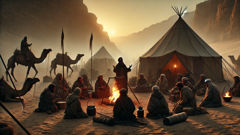
As caravans multiplied and the arteries of trade pumped riches—gold, incense, myrrh—through the region, the presence of these desert specialists became not only useful but essential. Foremost among their skills was watching: long, deliberate observation that could spot a spoor hours old or a change in caravan routine that signaled ambush. Their scouts could move with silence, blending into wadis and disappearing into mirages. City-dwellers, who spoke of power in terms of stone walls and chariots, mistook the nomads’ apparent freedom for disorder. Yet the Medjay had an order as strict as any barracks: oaths sworn beneath moonlight, councils held in the hush between dawn and the sun’s first bite. They formed roving bands that could repel a band of raiders or escort a pharaoh’s supply train through the most treacherous passes. The transition from mercenary scouts to royal protectors was gradual and negotiated: a caravan master saved by a band of Medjay would tell his story in Thebes; a grateful official would offer a ring of faience, a horse, a favor at court. Slowly, the name of the Medjay came to mean reliable guardians.
Their ascent was not merely transactional. The Medjay developed an ethic of guardianship that nested in ritual and in a particular kind of secrecy. It was said among them that protection demanded a reciprocity: the guardians would expend blood and stealth for those who honored the land’s boundaries and the gods’ thresholds. Their leaders—men and women of stern face and softer hearts—conducted a Covenant of Stones. During the covenant, a stone from the temple threshold and a stone from the desert floor were placed together, rubbed with date oil, and painted with a mixture of ochre and salt. To touch those stones and swear was to bind oneself to defend both city and shrine. The covenant turned transaction into devotion. The Medjay became shield-bearers at temple gates, silent watchers in corridor shadows where pharaohs passed, and guides who led sacred processions safely from shore to sanctuary. They learned the languages of priests and merchants and, in turn, taught city-slick courtiers something the palace could not buy: how to survive without a roof, how patience and listening could be sharper than a spear. The myth remembers not only victories but the quiet days when a Medjay walked alone to a shrine and, with a simple gesture—laying down a desert pebble—satisfied a vow that had kept a lineage in the land.
Yet their reputation was never without tension. There were moments when kings mistrusted those who answered only to oath and desert. There were rivalries with other military classes who favored displays of armor and chariot speed. The Medjay’s ethic—rooted in endurance rather than spectacle—at times made them suspect. But when raiders crept like vipers toward sacred sites and when tomb robbers dug under moonlight, it was the Medjay who stood between desecration and silence. Their tactics were almost invisible theater: a watch by the well that never moved, a rope looped in secret above a passage to trip a thief, a sudden charge from a concealed ridge. Their loyalty became legend because it was tested in the most private and most public of places: in the hush before ritual where a king prepared to commune with a god, and in the dead of night when a child’s life depended on steady hands and cool heads. The mythic image of the Medjay thus combines a practical origin with spiritual weight: nomads whose desert-born discipline translated into a sacred calling, guardians for whom the desert and the temple were part of the same world and worth defending at any cost.
Rituals, Rivalries, and the Sacred Bargain
Rituals formed the architecture of Medjay life. They were practical and poetic at once—meals eaten with eyes on the horizon, weapons oiled beside bowls of barley, prayers murmured for rains that rarely came. The most sacred ceremony was called The Mirror of Salt, performed when a child became a full member of the band. In a hollowed basin, elders poured water, and the child would gaze into its surface. The elders recited the names of saints and ancestors—names that in the mythic telling blurred between human and elemental: the Woman-of-The-Wadi, the Ibex-Clan, the Sand-Brother. The water’s surface was said to reflect not only a face, but the edges of a life, the tracks one would make. When the child acknowledged the reflection, placing three grains of salted date in the basin, the band accepted them, and the desert took them as kin. This rite bound an individual to a code where silence could be as binding as oath, and survival skills were taught with the gravity of scripture.
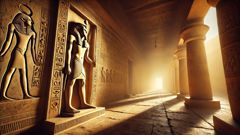
Their techniques were as varied as the landscape. They practiced a kind of camouflage that turned clothing into dunes and movement into wind. Their scouts placed small bundles tied to grasses to mark safe wells for returning caravans; they read the cadence of goat hooves to determine the number of riders in a distant group. They kept caches of food and hidden places where they would bury messages for one another. In battle, the Medjay avoided the flamboyance of pharaoh’s chariots and instead specialized in ambushes and counter-raid tactics. They could intercept raiders by night using pathways known only to those who had grown up among the stone; they would leave false tracks to lure pursuers into salt pans where horses would sink. These strategies were not mere military craft but belonged to a culture of adaptation—an ethic of using place rather than dominating it.
Yet the desert produced rivals as easily as it produced alliances. Neighboring groups, seeing the Medjay recruited by powerful rulers, grew jealous, and sometimes the Medjay themselves became entangled in the politics of the Nile. Kings who wished to bring the desert under firmer control offered lands, titles, and gold. The Medjay accepted some gifts and refused others, knowing that too much favor could erode their independence. The myth tells of a chieftain named Amunhotep-Sheru who accepted a crown of woven reed as a token from a prosperous pharaoh. He found himself slowly drawn into court intrigue, losing nights to feasts and becoming soft to desert wind. It took him, by his own later confession, a lonely night under the stars to realize that the crown could become a chain. He returned the reed crown to the wadi, breaking the gift beneath the same rock where his initiation had placed the first desert pebble, and in that act reasserted the Medjay code: guardianship, not governance.
Sacred bargains anchored their most dramatic responsibilities. The Medjay were entrusted with keeping certain routes inviolate so that priests could carry sacred items, and they paused the march of armies when religious protocol required. Stories in temple libraries and in the mouths of storytellers described scenes where Medjay formed living walls around royal processions, their spears lowered in solemn salute while incense smoke braided around their cloaks. It is said that one night a band of tomb robbers, greedy for gold, tried to break into a newly sealed burial chamber. The Medjay, led by a woman called Seti-Ra of Quiet Hands, laid a hidden snare that trapped the intruders. Instead of killing, they stripped the robbers of their weapons and dragged them before the temple priests to answer for their greed. The priests, impressed by the restraint and cunning, offered Seti-Ra a priestly sash. She refused, placing instead a small pebble from the tomb's threshold into the palm of the head priest. She said, ‘‘We are the keepers between stone and sky. We hold what you consecrate and do not become what you wear.’’
These tales made the Medjay more than muscle hired by the wealthy. They were spiritual custodians who, by ritual and craft, created a sacred geography that every traveler learned to respect. They taught that the desert itself had memory and that to trespass without acknowledgment was to invite ruin. Caravans learned to leave offerings at the wadi, to speak the names of the earth and wind. Temples learned to trust those who had no interest in thrones. Over centuries, the Medjay’s legend became legacy: their image carved in low relief at temple thresholds, depictions of desert boots and spears in tomb paintings, and names that echoed on lists of soldiers sworn to the pharaoh. Yet for all the honor, the myth preserved an intimacy: the Medjay's truest worship was practical. It was the careful tying of a horse’s bridle before a night ride, the quiet measure of a child's intake of water, the patient mending of sandal leather at dusk. Their reverence for the land and its boundaries expressed itself in every small duty, and it is these small rituals that the myth holds up like a lamp to the past.
Conclusion
The myth of the Medjay nomads is a story braided of survival, honor, and quiet power. It reminds us that there are forms of courage that do not clamor for monuments—courage that manifests in vigilance, in the refusal to let one sacred thing be taken for granted while another is celebrated. The Medjay were at once craftsmen of endurance and custodians of ritual, people who turned the hard skills of desert life into a moral vocabulary. They taught that protection could be a bridge between savage land and cultivated temple, that listening was a weapon just as precise as a spear. Even when kings changed and capitals moved, the image of the desert guardian remained: a silhouette against the horizon, alert to the secrets of sand and the whispers of the wind. Today, when scholars and travelers retrace ancient routes and when tourists stand before temple walls with carved figures of watchful men, the tale persists. The Medjay myth offers a lens through which to read the ancient world not only as a landscape of conquest and rule but as a geography of human practice, where survival skills matured into ethical systems. Their story calls us to honor practices that protect what we cherish—rituals of care, maps of memory, and the small, steady acts that bind communities to their places. In the hush of a desert evening, if one listens, the old songs might still be heard: low, slow, composed of rocks and breath, reminding us that guardianship is a work of ordinary devotion elevated into legend.

